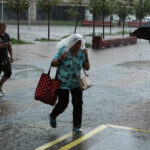Moscow has been hit by abnormal tropical downpours, thunderstorms, and hail. According to weather forecasts, up to half of the monthly rainfall will occur on July 4, with heavy rain persisting in some areas until the end of the day. A storm warning has been issued for Moscow and the surrounding region due to strong winds reaching speeds of up to 17 m/s. Footage from eyewitnesses shows flooding on Vyborgskaya Street—water is knee-deep, and cars are practically floating.
A similar situation has been reported in Ramenskoye, near Moscow. After every heavy rain, roads are severely flooded. The drainage systems simply can’t cope. The water eventually recedes, but not immediately. Currently, the situation on the roads has improved—most of the water has drained through the sewers, leaving fewer puddles. For some drivers, these floods aren’t critical due to their vehicle’s high clearance, but if the rain had continued all day, the flooding would have been much worse, with many stranded cars and frustrated drivers. Areas like Chetverty Kvartal Street and the exit from Chugunova to Kosmonavtov saw particularly severe flooding, with water levels reaching curbs in some places.
In some parts of the Moscow region, rainfall may exceed the monthly average. One of the biggest risks for drivers is hydro-lock, which occurs when water enters the engine through the air intake, causing severe damage. If a car is submerged for an extended period, the interior must be dried, electrical components treated, and wiring checked—a process that takes at least two to three days and can cost around 70,000–80,000 rubles.
Car insurance may not always cover flood damage, especially if the policy excludes hydro-lock. Drivers should check their insurance terms carefully. In emergencies, temporarily removing the air filter cover can help prevent water intake, but it must be reinstalled afterward.
Legal recourse is also uncertain. Courts assess whether the driver acted responsibly when entering a flooded area. If a car is parked legally but damaged due to overflowing rivers or extreme rainfall, liability may fall on authorities responsible for flood prevention. In some cases, compensation has been awarded when negligence in river maintenance was proven. However, gathering evidence against municipal or environmental agencies is difficult for individual drivers. The most effective course of action is filing complaints with regulatory bodies, such as the prosecutor’s office.
Despite the severe weather, Aeroexpress trains to Sheremetyevo and Domodedovo airports are running on schedule. The bad weather is expected to last until midweek, with rain gradually tapering off. By the weekend, sunny weather will return, with temperatures reaching 25–27°C during the day. Nights will remain warm, around 14–17°C. From Thursday onward, temperatures will slightly drop but remain mild, with occasional clouds and light rain.
Due to worsening road conditions, drivers in the capital have been advised to use public transport on August 4 and 5.
Vyborgskaya Street
Ramenskoye
Chetverty Kvartal Street
Chugunova
(If you meant a different “Chugunova,” please provide additional context!)



